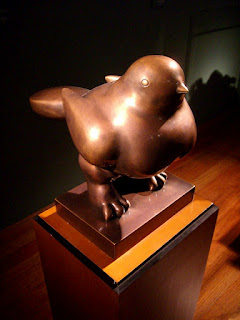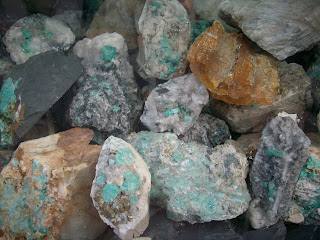Above left: Bogota's La Candelaria district; Above right: Catedral Primada de Colombia
Tuesday, 7 October 2008 - A journey's start
After an uneventful 12-hour flight from San Francisco (with a brief stop and connection in Atlanta), I was happy to land in Bogota but realized with some apprehension that I was no longer in California and it was time to rock and roll.
The cab ride from Bogota Colombia and South America ! I was sickened. You could not really tell who's a good or bad person these days. Someone told me to be careful as this part of the world was not the safest and he was right. Bam, on the first day of arrival! I dealt with it. My coping mechanism for the night would be to eat, shower and sleep the bad experience away.
Wednesday, 8 October 2008 - Catedral de Sal at Zipaquira
A few friends from the hostel and I took a tour out of Bogota to see Zipaquira’s Catedral de Sal. We took the TransMilenio (bus rapid transit system) fromBogota
A few friends from the hostel and I took a tour out of Bogota to see Zipaquira’s Catedral de Sal. We took the TransMilenio (bus rapid transit system) from
The Salt Cathedral was built inside a salt mine on three underground levels. The 14 Stations of the Cross were depicted in separate cavernous rooms along the passage way that led to the chapel and sanctuary area on the lowest level. I thought this was a big achievement for the locals to build such a structure over many years. A place of worship aside, I felt the site would make an interesting venue for a wedding or a holiday concert.
The old town of
Above left: Frag with a friendly stray; Above right: Zipaquira
Thursday, 9 October 2008 - Bogota on foot
What I liked about Cranky Croc Hostel was that it was centrally located in the La Candelaria district, which made sightseeing easy and convenient on foot. After a nice breakfast, I started the day with a tour of (the free) Museo (Fernando) Botero. While I knew that the Medellin-born artist and sculptor was renowned for his corpulent portraits and sculptures, I did not know that he had also created other works of still-life, animals and landscapes - all in the same plump proportions. It was interesting to see the world through his human lens and hands.
Above right: 'Mona Lisa' (1978 - rounder around the edges)
Above right: 'Pareja' (1993)
Above right: The courtyard at Museo Botero
Juan Valdez Café around the corner from the Museo Botero was a must stop for a coffee-addict like me. Walking into the shop and to be greeted by the wonderful aroma of caffeine in its finest put a big smile on my face. I ordered a Grande ‘Tinto’ (black coffee) with sprinkles of cinnamon powder on top (my usual). As a coffee-producing nation, Colombia
Above left: A Juan Valdez Café; Above right: A type of street food in Bogota
Moving on, I explored the rest of the La Candelaria area, rich with many old but beautifully maintained buildings (many as old as in the 1800’s). I wandered my way to the heart of historic Bogota
Above: Catedral Primada de Colombia
Above left: Some books by Colombia's most celebrated Nobel-prize novelist, Gabriel Garcia Marquez
Above: Emeralds from Colombia
The final stop for the day was Cerro de Montserrate, which stands at 3,150 m (10,335 ft) above sea-level. I took the teleferico (cable car) up to save time and energy and for 13,400 pesos (US$6.70) round-trip, it was a no-brainer. The view from the top was breathtaking (perhaps also influenced by the altitude?). It has been said that many who visit Montserrate hill do so in search of peace, penance, and reconciliation at the Montserrate Basilica.
As I was craving a traditional Colombian sit-down meal (after eating ‘fast’ food such as empanadas, arepas and fried chicken since I arrived in Colombia), I decided to splurge at the Restaurante Santafereño at Montserrate Hill. I ordered the Ajiaco con Pollo (a kind of chicken soup with corn and potato-based stock, accompanied with avocado and rice on the side) and it was devoured in no time at all. The best meal I’ve had in South America yet.
Above left: Restaurante Santafereño (inside Casa St. Clara - pictured); Above right: Ajiaco con pollo
Above left: Arepas y Empanadas; Above right: Fried chicken (pollo) with spuds





























































1 comment:
Well well well......
Post a Comment